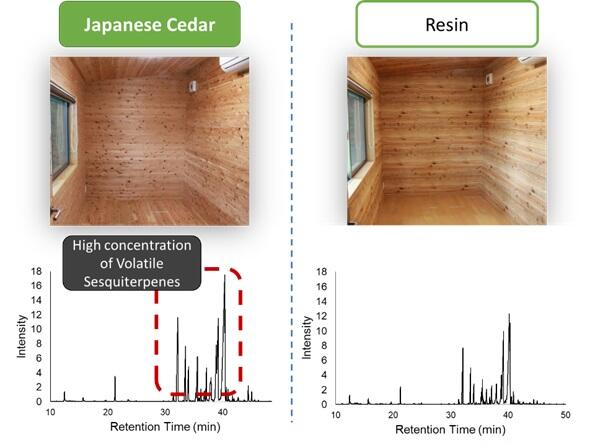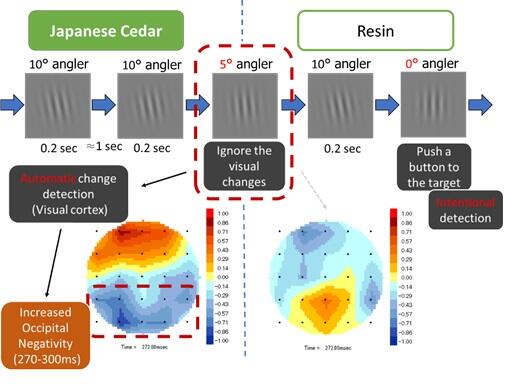A research group led by Research Assistant Professor Taisuke Nakashima and Associate Professor Kuniyoshi Shimizu of the School of Agriculture at Kyushu University, in collaboration with the Meeting to Study the Health of the Wooden House Cooperative Society (Cooperative Representative Director: Shinji Yasunari, CEO of YASUNARI Co., Ltd.), has discovered that the scent of cedarwood enhances human brain function when detecting visual changes. The results were obtained by measuring and comparing brain waves of participants while they performed a task in an experimental room in which natural cedarwood or resin‐based materials were used as interior cladding. The results are expected to form the basis for clarification of the functional effects of the scent of cedarwood. The results were published in the 30 March 2023 issue of the international scientific journal, Journal of Wood Science.

Provided by Kyushu University
Volatile organic compounds (VOCs) derived from cedarwood have been reported to have relaxing, antibacterial and antiviral effects, and research on their functionality is being conducted with the aim of increasing the demand for products other than building materials. The cedarwood VOCs are mainly a mixture of several types of organic molecules called 15‐carbon sesquiterpenes and other compounds and are considered difficult to synthesize chemically. To date, the research group has studied the functionality of forest biological resources that contribute to building a sustainable society. In 2020, they had reported that the scent of cedarwood had a stress‐reducing effect, irrespective of the participant's smell preferences.
The research group this time investigated the effects of solid cedarwood VOCs on brain functions related to visual perception. Visual perception is processed in the occipital visual cortex, a part of the brain that is also involved in the use of electronic devices, such as personal computers, which are used by modern people on a daily basis.
Specifically, two identical experimental huts, each with a floor area of 7.3 m² and a height of approximately 2 meters, were constructed on the university campus. The interior of one hut was constructed entirely of solid cedarwood, and the other was constructed entirely of resin‐based building materials with a wood‐grain appearance. Eighteen participants without psychiatric or neurological diseases participated in the experiment, and their brain waves were recorded and compared while they performed a task in each hut. In the experiment, a series of wrinkle‐like vertical stripes tilted at 10, 5 or 0 degrees (no tilt) were randomly displayed on the screen for 0.2 seconds at intervals of about 1 second, and the participants were required to press a button when they considered that the stripes showed no tilt.

Provided by Kyushu University
The results showed that the ECG components reflecting the automatic detection response seen at the infrequent 0 degrees of tilt stimuli, and at the easy‐to‐mistake 5 degrees of tilt stimuli, were significantly higher when the participants were in the hut with a cedarwood interior. Therefore, the cedarwood interior was believed to have improved the awareness response and cognitive function of the brain.
The research group plans to conduct a further study to confirm their findings in more realistic environments. They aim to compare the cognitive function of the residents after 3 months of residing in living facilities for the elderly, where private rooms are furnished either with cedarwood or new construction materials.
Journal Information
Publication: Journal of Wood Science
Title: Effects of volatile sesquiterpenes from Japanese cedarwood on visual processing in the human brain: an event‐related potential study
DOI: 10.1186/s10086‐023‐02083‐4
This article has been translated by JST with permission from The Science News Ltd. (https://sci-news.co.jp/) April 14th Edition. Unauthorized reproduction of the article and photographs is prohibited.




